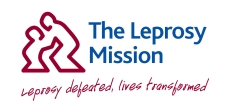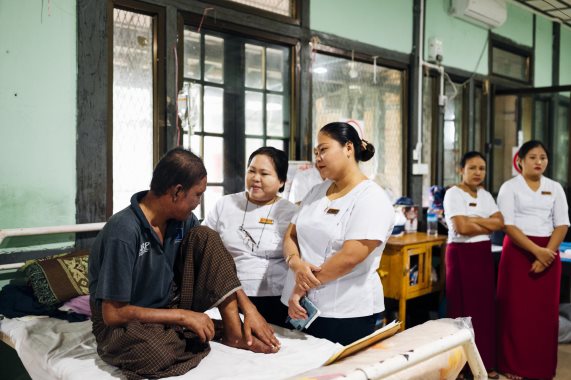
Coronavirus is Not Leprosy, But Lessons Can Still Be Learnt
UNITED KINGDOM / AGILITYPR.NEWS / April 07, 2020 / Nearly 150 years of experience in treating leprosy has taught The Leprosy Mission valuable lessons that must be transferred to the coronavirus (COVID-19) pandemic.
COVID-19 is very different from leprosy. COVID-19 is a highly contagious viral disease and leprosy is a mildly infectious bacterial disease that 95% of the world population is immune to. Although the two are very different scientifically, the social consequences run almost parallel.
Like COVID-19, leprosy is a disease that often sees the people affected face isolation. Because leprosy is a mildly infectious disease, this isolation is always unwarranted and often devastating.

Caption: Nurses with a patient at Mawlamyine Christian Leprosy Hospital, Myanmar
Copyright: The Leprosy Mission
Knowledge is a valuable asset
In the battle against leprosy, knowledge means that people in leprosy-affected communities are able to spot the signs of the disease at an early stage, when it’s possible to receive treatment before any of the severe consequences of the disease.
Brent Morgan, International Director of The Leprosy Mission said, “While knowledge and education might sound very basic, it is a silver bullet in our battle against leprosy and our battle against COVID-19. Everyone worldwide has a responsibility to ensure they understand the symptoms of COVID-19 and then act accordingly. We have seen that sharing misinformation within leprosy-affected communities has dire consequences, both in terms of stigma and the continued spread of the disease.”
Loving communities are transformative
Leprosy is a disease that brings with it a unique kind of isolation.
Brent continued, “Throughout our history we have been loving in our approach to treating this disease. This means administering treatment, caring for people in their suffering, and rehabilitating them afterwards so they can live full lives. Our closeness and support for people affected by leprosy has the effect of breaking down stigma and making difficult situations easier.
“In our coronavirus-affected societies, that love will manifest itself differently, but our experience of treating leprosy shows that love and care breeds a kind of consideration that can transform lives. Please remember that when you are shopping for groceries, out in public, or communicating about the disease and people affected online. It has worked for leprosy treatment and it will work for COVID-19.”
The Leprosy Mission is calling for an end to the use of the term ‘leper’ in relation to Covid-19
As people are facing forced or voluntary isolation there have been many headlines worldwide about how people can ‘feel like a leper’. The Leprosy Mission is calling on everyone to stop using this terminology and to stop comparing coronavirus to leprosy.
Brent continued, “The term ‘leper’ is deeply offensive to the millions of people worldwide who have been diagnosed with leprosy. Further, leprosy is a mildly infectious disease that 95% of the world population is immune to and COVID-19 is a highly contagious disease that has caused a global pandemic. It is important that we stop using this term as the misuse of this term creates more fear and stigma around leprosy.”
For more information about leprosy go to www.leprosymission.org.
About Us
The Leprosy Mission
The Leprosy Mission is an international Christian development organisation striving to defeat leprosy and transform lives. It serves people affected by leprosy, other neglected tropical diseases and disability.
About leprosy
- Leprosy is a mildly-infectious disease caused by a bacterium called Mycobacterium leprae (a relative of the tuberculosis bacterium or ‘TB’ germ). It can stay in the body for up to 20 years without showing symptoms.
- Leprosy causes nerve damage and, if left untreated, can lead to a loss of sensation in the hands and feet. This loss can lead to disability and the amputation of limbs. Leprosy also damages nerves in the face causing problems with blinking, eventually leading to blindness.
- Leprosy is not hereditary and it cannot be caught by touch.
- Leprosy is most common in places of poverty where overcrowding and poor nutrition and housing allow people to become more susceptible to leprosy infection.
- Leprosy is curable with multidrug therapy (MDT), which was developed in the 1980s. Within one day of starting MDT there is no risk of the disease spreading to anyone else. Lack of education, however, means that many people affected by leprosy are still stigmatised, even after they have been cured, especially if the disease has caused disability.
- Latest statistics reveal in 2018 there were 208,619 new cases of leprosy diagnosed. More than half of those (148,495) were found in South-East Asia.1
1 WHO Weekly epidemiological record, Global Leprosy Update 30 AUGUST 2019, 35/36, 2019, 94, 389–412
Contacts
Tim Burton
Senior Officer, Communication
tim.burton@leprosymission.orgThe Leprosy Mission International
Phone: +44 (0)20 8326 6731 Mobile: +44 (0)7407 803 025